Mapping Aquaculture Ponds for the Coastal Zone of Asia with Sentinel-1 and Sentinel-2 Time Series
Abstract
1. Introduction
1.1. Asia’s Role in Global Aquaculture Production
1.2. Extracting Aquaculture Using Earth Observation
2. Study Region
3. Data and Methods
3.1. Satellite Data
3.1.1. Sentinel-1 Time Series Data
3.1.2. Sentinel-2 Time Series Data
3.2. Auxilliary Data
3.2.1. DEM Data
3.2.2. Administrative Boundary Data
3.2.3. Coastline Data
3.2.4. Statistical Data
3.3. Satellite Data Processing
3.3.1. Preprocessing of Sentinel Time Series
3.3.2. Derivation of Temporal Metrics
3.3.3. Segmentation
3.4. Pond Objects Filtering (Post-Processing)
3.4.1. Vector Attribute Filtering Using Geometric Features
3.4.2. Filtering of Natural Water Bodies
3.5. Accuracy Assessment
3.6. Geospatial and Statistical Data Analysis
4. Results
4.1. Aquaculture Mapping Results for Coastal Asia
4.2. National Statistical Analysis
4.3. Hotspot Analysis
5. Discussion
- (1)
- a key feature of the novel, continental-scale mapping approach is the use of free and open remote sensing data; the launches of Sentinel-1C and 1D will provide data continuity and satellite-based high-resolution SAR data and enable continuous monitoring over the next decade;
- (2)
- the application of a simple and fast segmentation algorithm and scalable processing capabilities within the cloud platform provide the capacity and ability to upscale the framework and enable global mapping of coastal pond aquaculture;
- (3)
- the use of open source tools and software creates the possibility of integrating other or updated pre- and post-processing toolboxes, image processing, computer vision models, or algorithms into the framework.
6. Conclusions
Author Contributions
Funding
Institutional Review Board Statement
Informed Consent Statement
Acknowledgments
Conflicts of Interest
Appendix A
References
- FAO Fishery and Aquaculture Statistics. Global Aquaculture Production 1950–2019 (FishstatJ). In FAO Fisheries Division; FAO: Rome, Italy, 2021. [Google Scholar]
- Gephart, J.A.; Golden, C.D.; Asche, F.; Belton, B.; Brugere, C.; Froehlich, H.E.; Fry, J.P.; Halpern, B.S.; Hicks, C.C.; Jones, R.C.; et al. Scenarios for Global Aquaculture and Its Role in Human Nutrition. Rev. Fish. Sci. Aquac. 2021, 29, 122–138. [Google Scholar] [CrossRef]
- Thilsted, S.H.; Thorne-Lyman, A.; Webb, P.; Bogard, J.R.; Subasinghe, R.; Phillips, M.J.; Allison, E.H. Sustaining Healthy Diets: The Role of Capture Fisheries and Aquaculture for Improving Nutrition in the Post-2015 Era. Food Policy 2016, 61, 126–131. [Google Scholar] [CrossRef]
- Blanchard, J.L.; Watson, R.A.; Fulton, E.A.; Cottrell, R.S.; Nash, K.L.; Bryndum-Buchholz, A.; Büchner, M.; Carozza, D.A.; Cheung, W.W.L.; Elliott, J.; et al. Linked Sustainability Challenges and Trade-Offs among Fisheries, Aquaculture and Agriculture. Nat. Ecol. Evol. 2017, 1, 1240–1249. [Google Scholar] [CrossRef]
- Belton, B.; Thilsted, S.H. Fisheries in Transition: Food and Nutrition Security Implications for the Global South. Glob. Food Secur. 2014, 3, 59–66. [Google Scholar] [CrossRef]
- Fiedler, J.L.; Lividini, K.; Drummond, E.; Thilsted, S.H. Strengthening the Contribution of Aquaculture to Food and Nutrition Security: The Potential of a Vitamin A-Rich, Small Fish in Bangladesh. Aquaculture 2016, 452, 291–303. [Google Scholar] [CrossRef]
- Béné, C.; Barange, M.; Subasinghe, R.; Pinstrup-Andersen, P.; Merino, G.; Hemre, G.-I.; Williams, M. Feeding 9 Billion by 2050—Putting Fish Back on the Menu. Food Secur. 2015, 7, 261–274. [Google Scholar] [CrossRef]
- Akber, M.A.; Aziz, A.A.; Lovelock, C. Major Drivers of Coastal Aquaculture Expansion in Southeast Asia. Ocean. Coast. Manag. 2020, 198, 105364. [Google Scholar] [CrossRef]
- Ahmed, N.; Thompson, S.; Glaser, M. Global Aquaculture Productivity, Environmental Sustainability, and Climate Change Adaptability. Environ. Manag. 2019, 63, 159–172. [Google Scholar] [CrossRef] [PubMed]
- Dauda, A.B.; Ajadi, A.; Tola-Fabunmi, A.S.; Akinwole, A.O. Waste Production in Aquaculture: Sources, Components and Managements in Different Culture Systems. Aquac. Fish. 2019, 4, 81–88. [Google Scholar] [CrossRef]
- Ottinger, M.; Clauss, K.; Kuenzer, C. Aquaculture: Relevance, Distribution, Impacts and Spatial Assessments—A Review. Ocean. Coast. Manag. 2016, 119, 244–266. [Google Scholar] [CrossRef]
- Newton, R.; Zhang, W.; Xian, Z.; McAdam, B.; Little, D.C. Intensification, Regulation and Diversification: The Changing Face of Inland Aquaculture in China. Ambio 2021, 50, 1739–1756. [Google Scholar] [CrossRef]
- Hua, K.; Cobcroft, J.M.; Cole, A.; Condon, K.; Jerry, D.R.; Mangott, A.; Praeger, C.; Vucko, M.J.; Zeng, C.; Zenger, K.; et al. The Future of Aquatic Protein: Implications for Protein Sources in Aquaculture Diets. One Earth 2019, 1, 316–329. [Google Scholar] [CrossRef]
- Tacon, A.G.J. Trends in Global Aquaculture and Aquafeed Production: 2000–2017. Rev. Fish. Sci. Aquac. 2020, 28, 43–56. [Google Scholar] [CrossRef]
- Tacon, A.G.J.; Metian, M. Global Overview on the Use of Fish Meal and Fish Oil in Industrially Compounded Aquafeeds: Trends and Future Prospects. Aquaculture 2008, 285, 146–158. [Google Scholar] [CrossRef]
- Maulu, S.; Hasimuna, O.J.; Haambiya, L.H.; Monde, C.; Musuka, C.G.; Makorwa, T.H.; Munganga, B.P.; Phiri, K.J.; Nsekanabo, J.D. Climate Change Effects on Aquaculture Production: Sustainability Implications, Mitigation, and Adaptations. Front. Sustain. Food Syst. 2021, 5, 70. [Google Scholar] [CrossRef]
- Bostock, J.; McAndrew, B.; Richards, R.; Jauncey, K.; Telfer, T.; Lorenzen, K.; Little, D.; Ross, L.; Handisyde, N.; Gatward, I.; et al. Aquaculture: Global Status and Trends. Philos. Trans. R. Soc. Lond. B Biol. Sci. 2010, 365, 2897–2912. [Google Scholar] [CrossRef]
- Lazard, J.; Baruthio, A.; Mathé, S.; Rey-Valette, H.; Chia, E.; Clément, O.; Aubin, J.; Morissens, P.; Mikolasek, O.; Legendre, M.; et al. Aquaculture System Diversity and Sustainable Development: Fish Farms and Their Representation. Aquat. Living Resour. 2010, 23, 187–198. [Google Scholar] [CrossRef]
- Ottinger, M.; Kuenzer, C. Spaceborne L-Band Synthetic Aperture Radar Data for Geoscientific Analyses in Coastal Land Applications: A Review. Remote Sens. 2020, 12, 2228. [Google Scholar] [CrossRef]
- Cherif, E.K.; Mozetič, P.; Francé, J.; Flander-Putrle, V.; Faganeli-Pucer, J.; Vodopivec, M. Comparison of In-Situ Chlorophyll-a Time Series and Sentinel-3 Ocean and Land Color Instrument Data in Slovenian National Waters (Gulf of Trieste, Adriatic Sea). Water 2021, 13, 1903. [Google Scholar] [CrossRef]
- Kuenzer, C.; Dech, S.; Wagner, W. Remote Sensing Time Series Revealing Land Surface Dynamics: Status Quo and the Pathway Ahead. In Remote Sensing Time Series: Revealing Land Surface Dynamics; Remote Sensing and Digital Image Processing; Kuenzer, C., Dech, S., Wagner, W., Eds.; Springer: Berlin/Heidelberg, Germany, 2015; pp. 1–24. ISBN 978-3-319-15967-6. [Google Scholar]
- Alexandridis, T.K.; Topaloglou, C.A.; Lazaridou, E.; Zalidis, G.C. The Performance of Satellite Images in Mapping Aquacultures. Ocean. Coast. Manag. 2008, 51, 638–644. [Google Scholar] [CrossRef]
- Marini, Y.; Prayogo, T.; Hanzah, R.; Hasyim, B. Fishpond Aquaculture Inventory in Maros Regency of South Sulawesi Province. Int. J. Remote Sens. Earth Sci. 2013, 10, 25–35. [Google Scholar] [CrossRef][Green Version]
- Sridhar, P.N.; Surendran, A.; Ramana, I.V.; Surendran, A.; Ramana, I.V. Auto-Extraction Technique-Based Digital Classification of Saltpans and Aquaculture Plots Using Satellite Data. Int. J. Remote Sens. 2008, 29, 313–323. [Google Scholar] [CrossRef]
- Virdis, S.G.P. An Object-Based Image Analysis Approach for Aquaculture Ponds Precise Mapping and Monitoring: A Case Study of Tam Giang-Cau Hai Lagoon, Vietnam. Environ. Monit. Assess. 2014, 186, 117–133. [Google Scholar] [CrossRef]
- Zhang, T.; Li, Q.; Yang, X.; Zhou, C.; Su, F. Automatic Mapping Aquaculture in Coastal Zone from TM Imagery with OBIA Approach. In Proceedings of the 18th International Conference on Geoinformatics, Beijing, China, 18–20 June 2010; pp. 1–4. [Google Scholar]
- Chi, M.; Plaza, A.; Benediktsson, J.A.; Sun, Z.; Shen, J.; Zhu, Y. Big Data for Remote Sensing: Challenges and Opportunities. Proc. IEEE 2016, 104, 2207–2219. [Google Scholar] [CrossRef]
- Gorelick, N.; Hancher, M.; Dixon, M.; Ilyushchenko, S.; Thau, D.; Moore, R. Google Earth Engine: Planetary-Scale Geospatial Analysis for Everyone. Remote Sens. Environ. 2017, 202, 18–27. [Google Scholar] [CrossRef]
- Duan, Y.; Li, X.; Zhang, L.; Chen, D.; Liu, S.; Ji, H. Mapping National-Scale Aquaculture Ponds Based on the Google Earth Engine in the Chinese Coastal Zone. Aquaculture 2020, 520, 734666. [Google Scholar] [CrossRef]
- Ren, C.; Wang, Z.; Zhang, Y.; Zhang, B.; Chen, L.; Xi, Y.; Xiao, X.; Doughty, R.B.; Liu, M.; Jia, M.; et al. Rapid Expansion of Coastal Aquaculture Ponds in China from Landsat Observations during 1984–2016. Int. J. Appl. Earth Obs. Geoinf. 2019, 82, 101902. [Google Scholar] [CrossRef]
- Xia, Z.; Guo, X.; Chen, R. Automatic Extraction of Aquaculture Ponds Based on Google Earth Engine. Ocean. Coast. Manag. 2020, 198, 105348. [Google Scholar] [CrossRef]
- Ottinger, M.; Clauss, K.; Kuenzer, C. Large-Scale Assessment of Coastal Aquaculture Ponds with Sentinel-1 Time Series Data. Remote Sens. 2017, 9, 440. [Google Scholar] [CrossRef]
- Ottinger, M.; Clauss, K.; Kuenzer, C. Opportunities and Challenges for the Estimation of Aquaculture Production Based on Earth Observation Data. Remote Sens. 2018, 10, 1076. [Google Scholar] [CrossRef]
- Prasad, K.A.; Ottinger, M.; Wei, C.; Leinenkugel, P. Assessment of Coastal Aquaculture for India from Sentinel-1 SAR Time Series. Remote Sens. 2019, 11, 357. [Google Scholar] [CrossRef]
- Stiller, D.; Ottinger, M.; Leinenkugel, P. Spatio-Temporal Patterns of Coastal Aquaculture Derived from Sentinel-1 Time Series Data and the Full Landsat Archive. Remote Sens. 2019, 11, 1707. [Google Scholar] [CrossRef]
- Sun, Z.; Luo, J.; Yang, J.; Yu, Q.; Zhang, L.; Xue, K.; Lu, L. Nation-Scale Mapping of Coastal Aquaculture Ponds with Sentinel-1 SAR Data Using Google Earth Engine. Remote Sens. 2020, 12, 3086. [Google Scholar] [CrossRef]
- Neumann, B.; Vafeidis, A.T.; Zimmermann, J.; Nicholls, R.J. Future Coastal Population Growth and Exposure to Sea-Level Rise and Coastal Flooding—A Global Assessment. PLoS ONE 2015, 10, e0118571. [Google Scholar] [CrossRef]
- GADM Global Administrative Areas. GADM Database of Global Administrative Areas, Version 2.0. 2012. Available online: https://gadm.org (accessed on 10 November 2021).
- European Commission. Joint Research Centre GHS-POP R2015A—GHS Population Grid; Derived from GPW4; European Commission: Brussels, Belgium, 2015. [Google Scholar]
- Nguyen, M.T.; Renaud, F.G.; Sebesvari, Z. Drivers of Change and Adaptation Pathways of Agricultural Systems Facing Increased Salinity Intrusion in Coastal Areas of the Mekong and Red River Deltas in Vietnam. Environ. Sci. Policy 2019, 92, 331–348. [Google Scholar] [CrossRef]
- Lebel, L.; Lebel, P.; Soe, K.M.; Phuong, N.T.; Navy, H.; Phousavanh, P.; Jutagate, T.; Akester, M.; Lebel, B. Aquaculture Farmers’ Perceptions of Climate-Related Risks in the Mekong Region. Reg. Environ. Chang. 2020, 20, 95. [Google Scholar] [CrossRef]
- McGranahan, G.; Balk, D.; Anderson, B. The Rising Tide: Assessing the Risks of Climate Change and Human Settlements in Low Elevation Coastal Zones. Environ. Urban. 2007, 19, 17–37. [Google Scholar] [CrossRef]
- ESA. Sentinel-1 User Handbook; ESA: Paris, France, 2013. [Google Scholar]
- Torres, R.; Snoeij, P.; Geudtner, D.; Bibby, D.; Davidson, M.; Attema, E.; Potin, P.; Rommen, B.; Floury, N.; Brown, M.; et al. Remote Sensing of Environment GMES Sentinel-1 Mission. Remote Sens. Environ. 2012, 120, 9–24. [Google Scholar] [CrossRef]
- Schubert, A.; Small, D.; Miranda, N.; Geudtner, D.; Meier, E. Sentinel-1A Product Geolocation Accuracy: Commissioning Phase Results. Remote Sens. 2015, 7, 9431–9449. [Google Scholar] [CrossRef]
- Louis, J.; Pflug, B.; Main-Knorn, M.; Debaecker, V.; Mueller-Wilm, U.; Iannone, R.Q.; Giuseppe Cadau, E.; Boccia, V.; Gascon, F. Sentinel-2 Global Surface Reflectance Level-2a Product Generated with Sen2Cor. In Proceedings of the IGARSS 2019—2019 IEEE International Geoscience and Remote Sensing Symposium, Yokohama, Japan, 28 July–2 August 2019; pp. 8522–8525. [Google Scholar]
- NASA Jet Propulsion Laboratory (JPL) NASA Shuttle Radar Topography Mission 1 Arc Second. Version 3.0; 2013. Available online: https://cmr.earthdata.nasa.gov/search/concepts/C1000000240-LPDAAC_ECS.html (accessed on 10 November 2021).
- Farr, T.G.; Rosen, P.A.; Caro, E.; Crippen, R.; Duren, R.; Hensley, S.; Kobrick, M.; Paller, M.; Rodriguez, E.; Roth, L.; et al. The Shuttle Radar Topography Mission. Rev. Geophys. 2007, 45, 25–36. [Google Scholar] [CrossRef]
- Garibaldi, L. The FAO Global Capture Production Database: A Six-Decade Effort to Catch the Trend. Mar. Policy 2012, 36, 760–768. [Google Scholar] [CrossRef]
- Younos, T.M.A. Advances in Water Monitoring Research; Water Resources Publication: Littleton, CO, USA, 2002; p. 244. [Google Scholar]
- Gao, B. NDWI—A Normalized Difference Water Index for Remote Sensing of Vegetation Liquid Water from Space. Remote Sens. Environ. 1996, 58, 257–266. [Google Scholar] [CrossRef]
- McFeeters, S.K. The Use of the Normalized Difference Water Index (NDWI) in the Delineation of Open Water Features. Int. J. Remote Sens. 1996, 17, 1425–1432. [Google Scholar] [CrossRef]
- Xu, H. Modification of Normalised Difference Water Index (NDWI) to Enhance Open Water Features in Remotely Sensed Imagery. Int. J. Remote Sens. 2006, 27, 3025–3033. [Google Scholar] [CrossRef]
- Otsu, N. A Threshold Selection Method from Gray-Level Histograms. IEEE Trans. Syst. Man Cybern. 1979, 9, 62–66. [Google Scholar] [CrossRef]
- Congalton, R.G.; Green, K. Assessing the Accuracy of Remotely Sensed Data: Principles and Practices, 2nd ed.; CRC Press: Boca Raton, FL, USA, 2008; ISBN 978-0-429-14397-7. [Google Scholar]

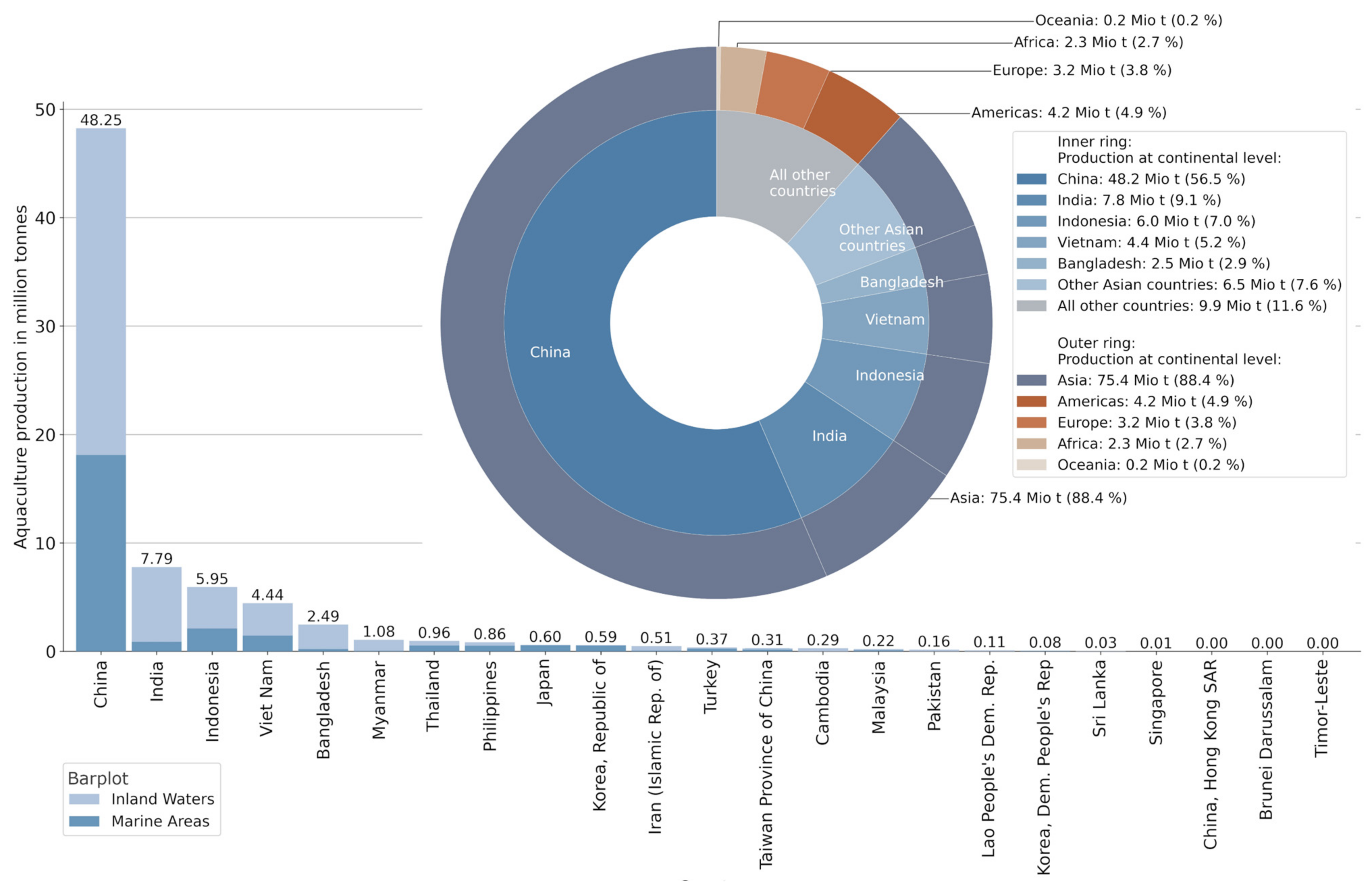


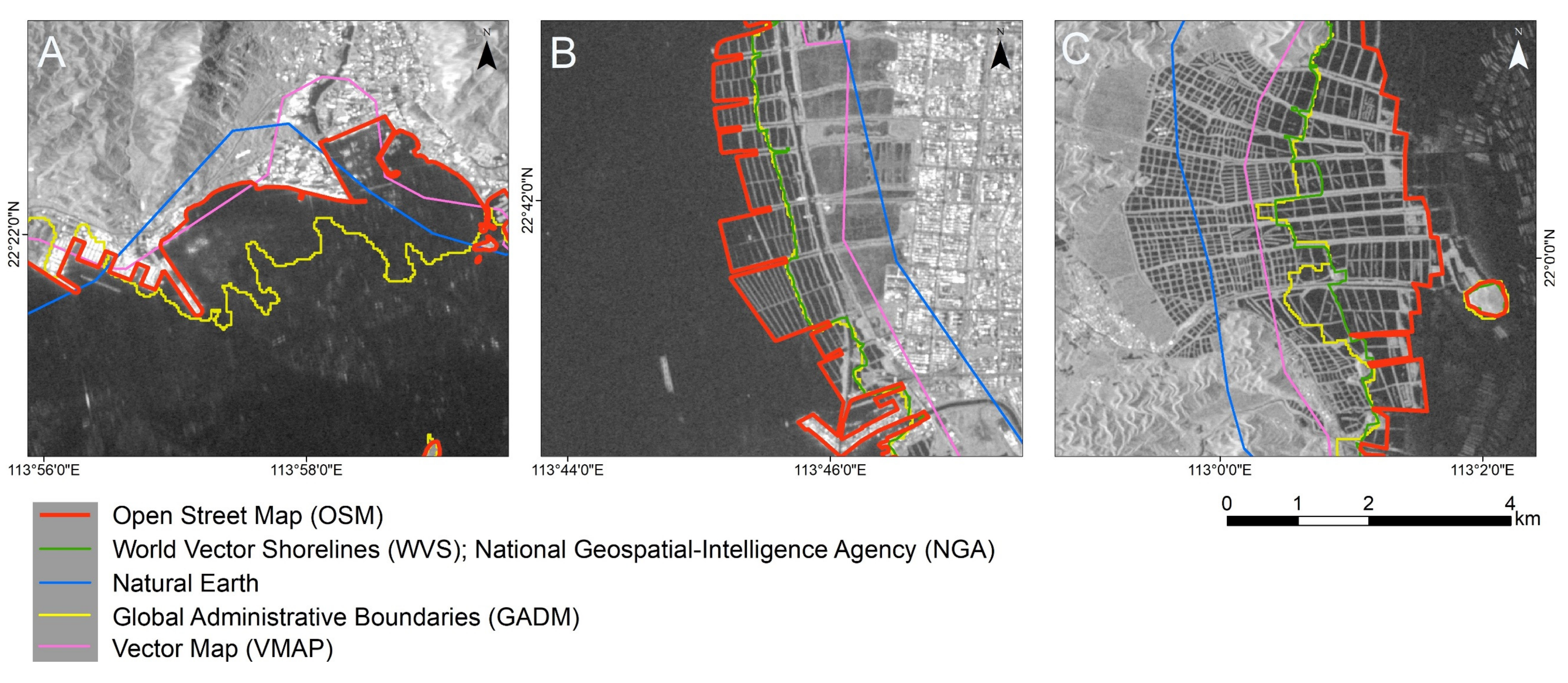

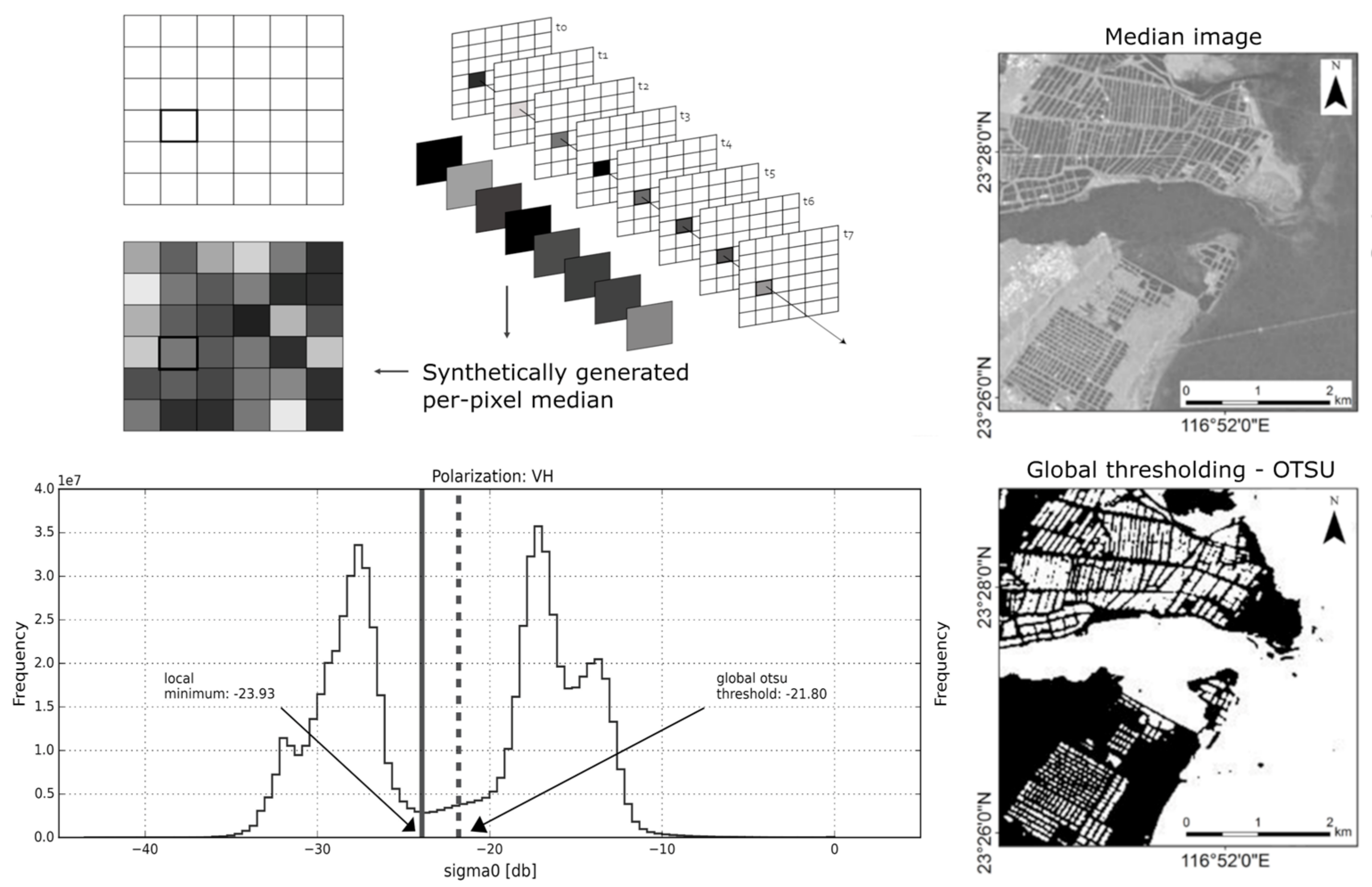
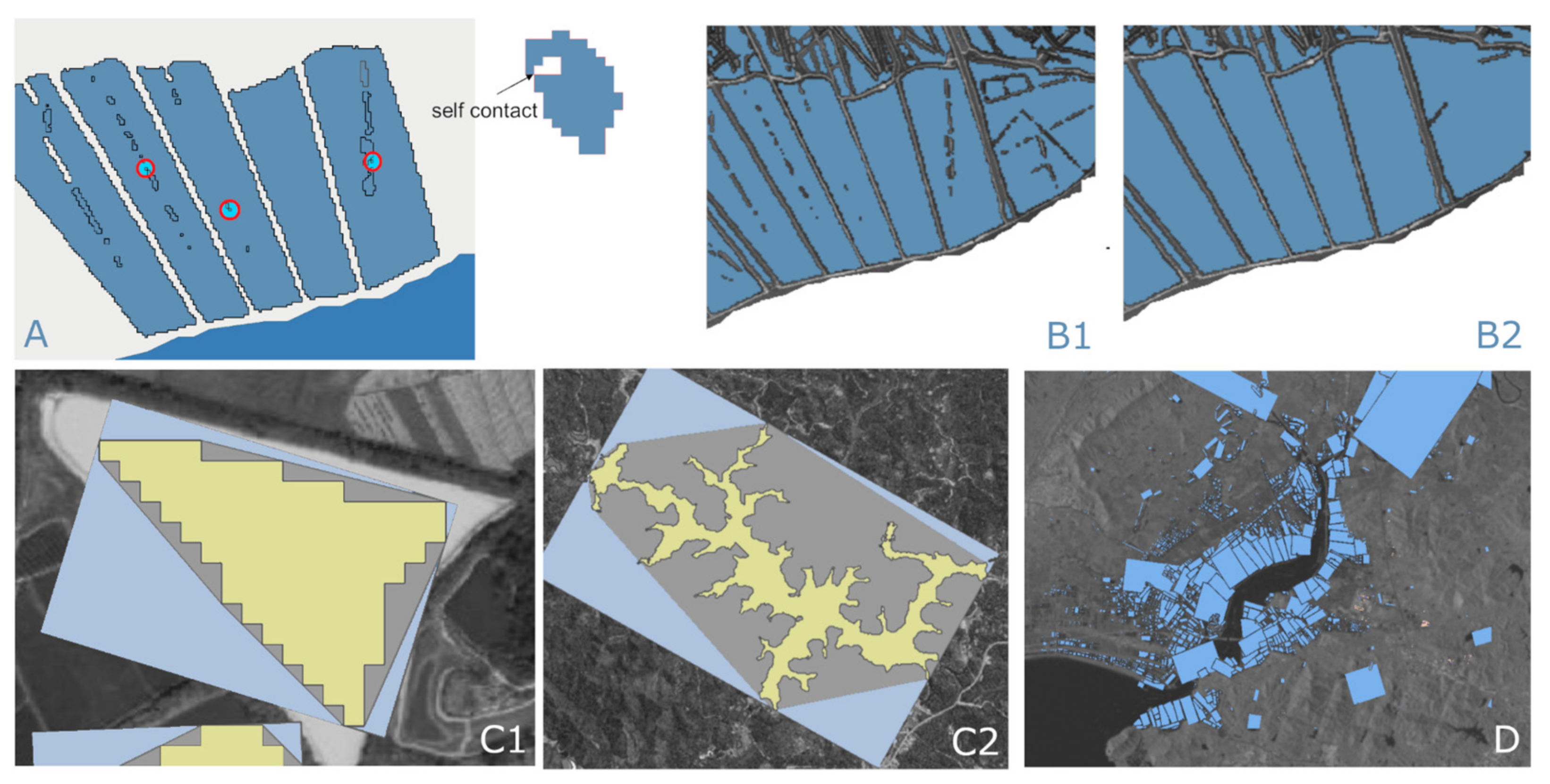
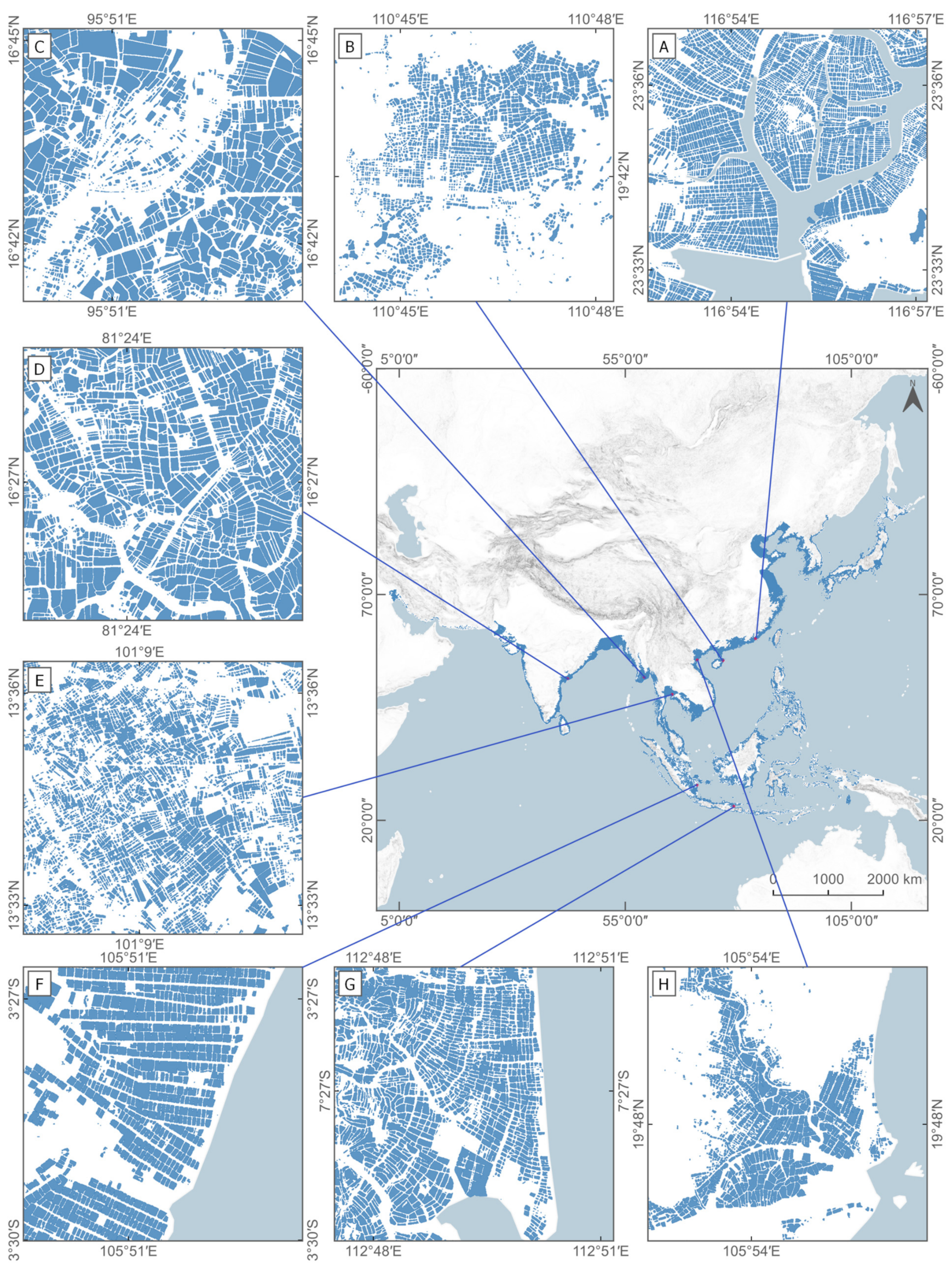
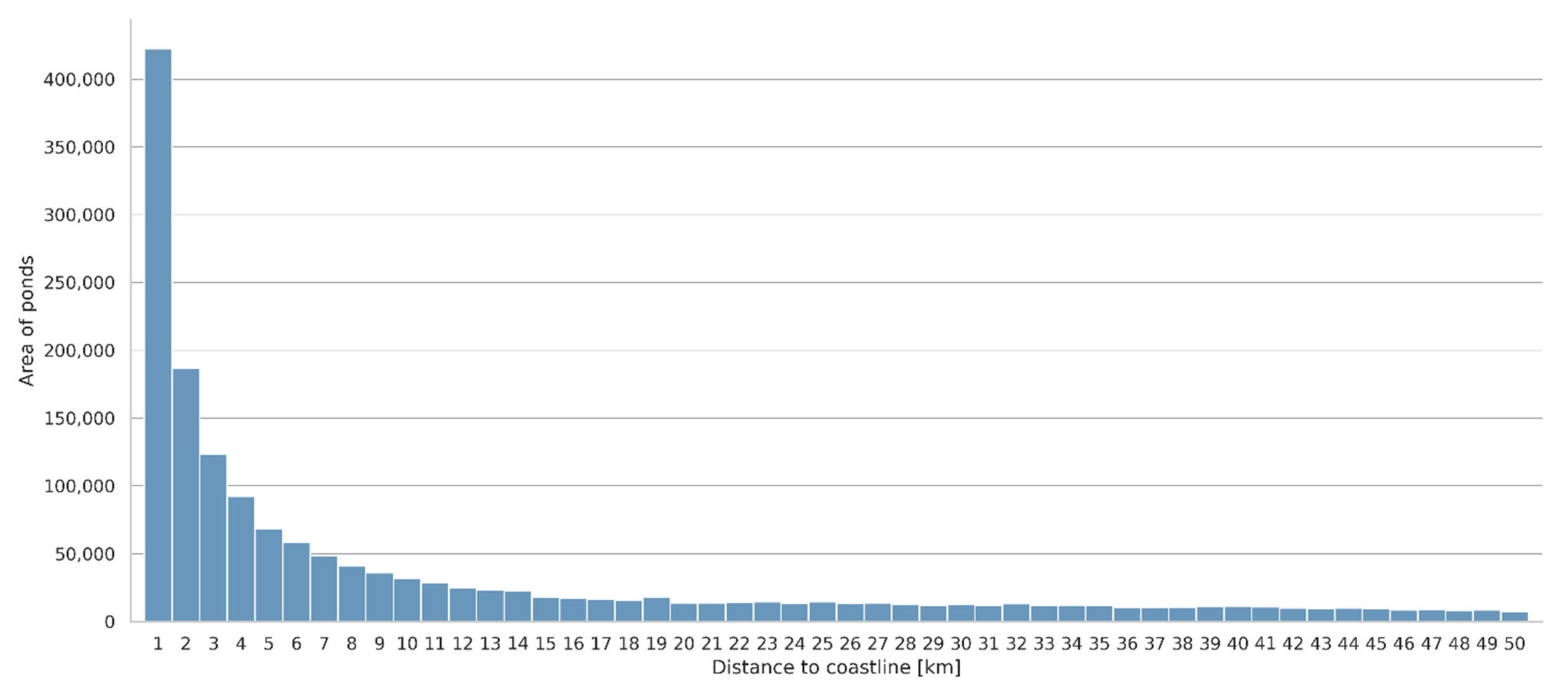
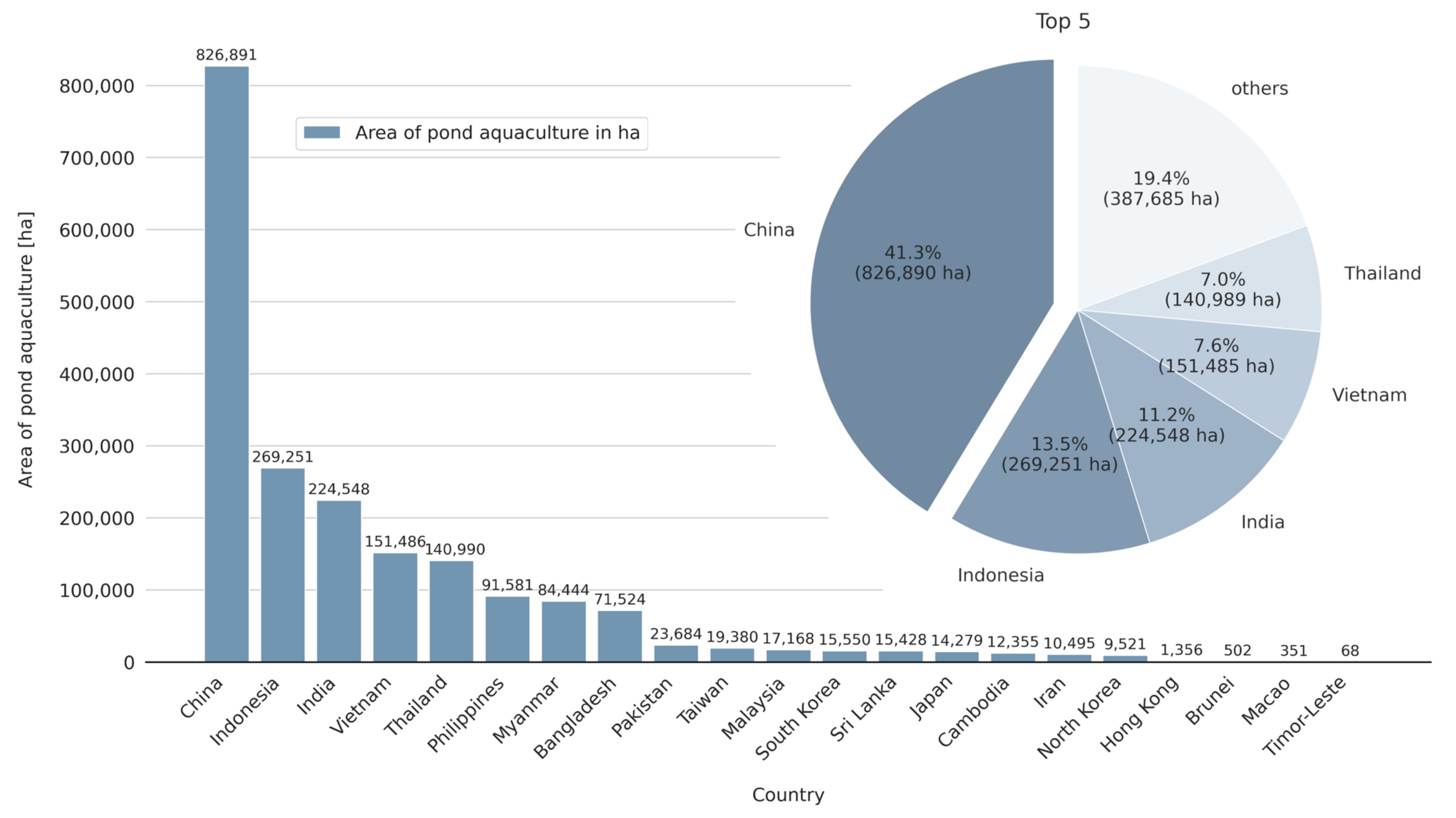
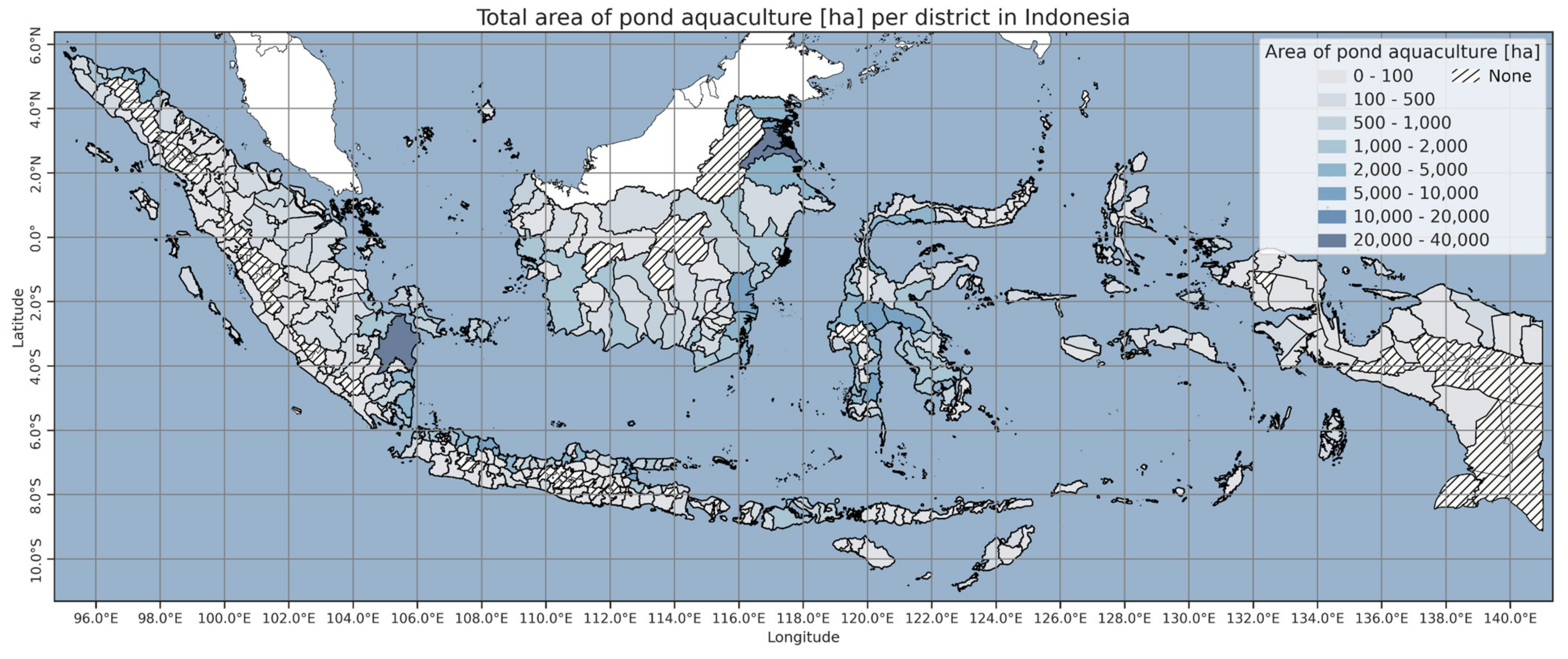

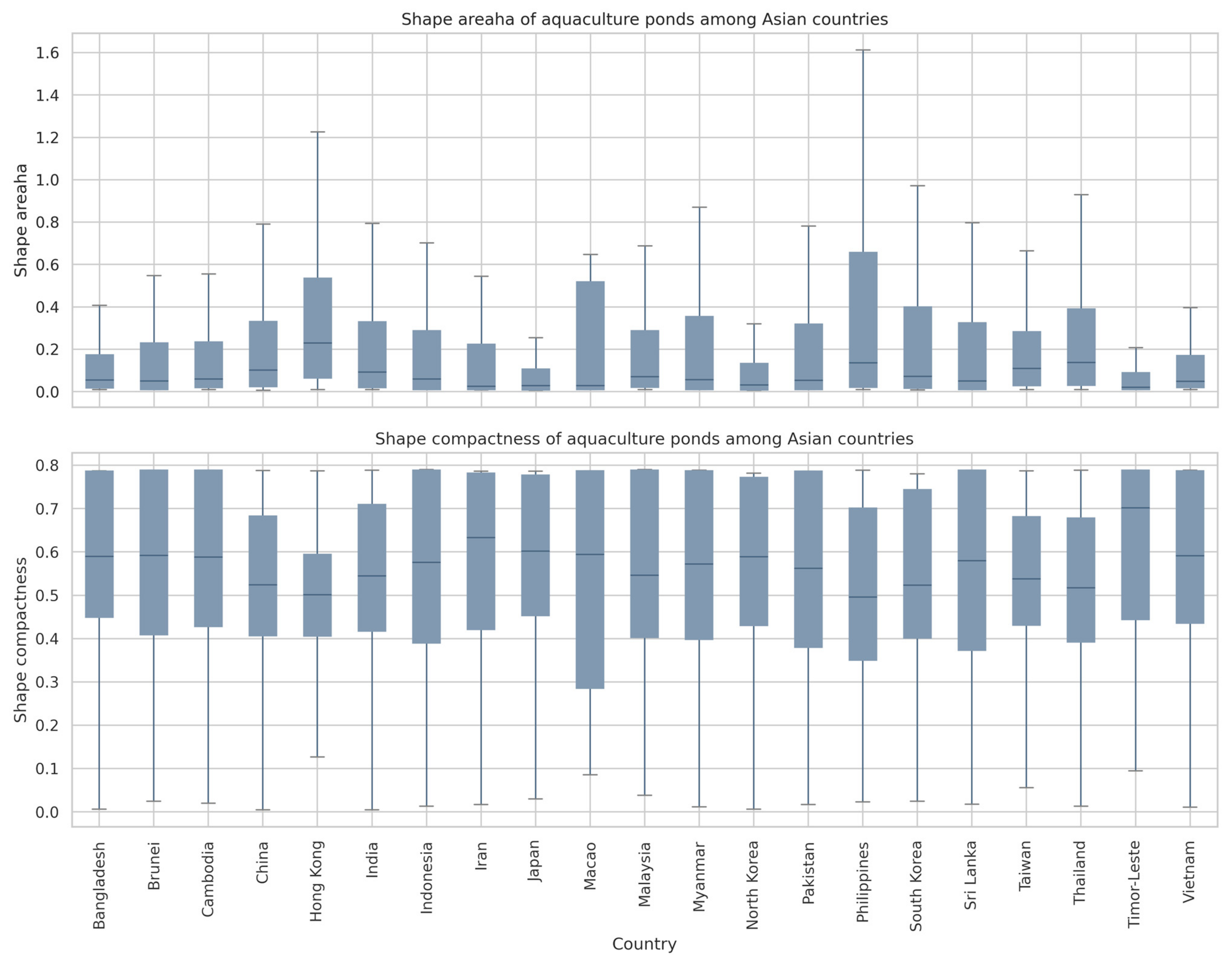

| Country | ISO 3166-1 Alpha-3 Code | Coastline Length a [km] | Land Area b [km²] | Coastline a/ Land Area a Ratio [m/km2] | Total Population (TP) c [in Mio] | Population in the Coastal Zone (PCZA) d [in Mio] | Share of PCZA in Relation to TP [in %] |
|---|---|---|---|---|---|---|---|
| Indonesia | IDN | 97,680 | 1,878,758 | 51.99 | 267.67 | 250.32 | 93.5 |
| Philippines | PHL | 34,541 | 293,319 | 117.76 | 106.65 | 96.78 | 90.7 |
| China | CHN | 34,362 | 9,371,977 | 3.67 | 1459.38 | 429.65 | 29.4 |
| Japan | JPN | 30,725 | 372,424 | 82.50 | 127.20 | 121.38 | 95.4 |
| Myanmar | MMR | 18,008 | 662,913 | 27.16 | 53.71 | 28.52 | 53.1 |
| Republic of Korea | KOR | 14,930 | 96,857 | 154.14 | 51.17 | 48.40 | 94.6 |
| India | IND | 13,166 | 3,150,820 | 4.18 | 1352.64 | 386.57 | 28.6 |
| Malaysia | MYS | 12,465 | 327,849 | 38.02 | 31.53 | 29.73 | 94.3 |
| Thailand | THA | 8182 | 514,480 | 15.90 | 69.43 | 39.09 | 56.3 |
| Vietnam | VNM | 6217 | 328,898 | 18.90 | 95.55 | 87.09 | 91.1 |
| Iran | IRN | 5858 | 1,622,136 | 3.61 | 81.80 | 10.48 | 12.8 |
| Pakistan | PAK | 4936 | 872,877 | 5.65 | 212.23 | 24.27 | 11.4 |
| Dem. People’s Rep. Korea | PRK | 4896 | 121,458 | 40.31 | 25.55 | 23.71 | 92.8 |
| Sri Lanka | LKA | 3930 | 66,288 | 59.29 | 21.23 | 20.58 | 96.9 |
| Taiwan | TWN | 2863 | 36,207 | 79.07 | 23.73 | 23.06 | 97.2 |
| Bangladesh | BGD | 2735 | 137,208 | 19.93 | 161.38 | 82.94 | 51.4 |
| Cambodia | KHM | 1430 | 181,058 | 7.90 | 16.25 | 10.91 | 67.1 |
| Hong Kong SAR | HKG | 1101 | 1038 | 1060.56 | 7.37 | 5.93 | 80.5 |
| Timor-Leste | TLS | 803 | 15,083 | 53.24 | 1.27 | 1.17 | 92.1 |
| Singapore | SGP | 490 | 511 | 959.73 | 5.76 | 5.44 | 94.4 |
| Brunei Darussalam | BRN | 298 | 5713 | 52.16 | 0.43 | 0.43 | 100.0 |
| Macao SAR | MAC | 89 | 29 | 3068.01 | 0.63 | 0.40 | 63.5 |
| ROI total (22 countries) | 299,705 | 20,057,900 | Ø 269.26 | 4173 | 1726 | 41.4 | |
| South Asia (SA) | 30,625 | 5,849,329 | Ø 18.53 | 1829 | 524.84 | 28.7 | |
| Southeast Asia Mainland (SEAL) | 38,474 | 1,819,271 | Ø 176.86 | 267 | 194.76 | 73.1 | |
| Southeast Asia Maritime (SEAM) | 141,640 | 2,389,311 | Ø 63.50 | 383 | 354.71 | 92.7 | |
| East Asia (EA) | 38,415 | 9,409,251 | Ø 1,052.83 | 1491 | 459.04 | 30.8 | |
| Northeast Asia (NEA) | 50,551 | 590,739 | Ø 92.32 | 204 | 193.49 | 94.9 | |
| Sentinel-1A/B IW GRDH | Number of Scenes | |||
|---|---|---|---|---|
| Ascending Orbit | Descending Orbit | Ascending + Descending Orbit | ||
| Quarter I 2019 | 1 January–31 March | 2959 | 3168 | 6127 |
| Quarter II 2019 | 1 April–30 June | 2940 | 3088 | 6028 |
| Quarter III 2019 | 1 July–30 September | 3160 | 3229 | 6389 |
| Quarter IV 2019 | 1 October–31 December | 3144 | 3746 | 6890 |
| Total | 12,203 | 13,231 | 25,434 | |
| Country | Total * | Fishes | Crustaceans | Mollusks | ||||
|---|---|---|---|---|---|---|---|---|
| tons | World Share (%) | tons | World Share (%) | tons | World Share (%) | tons | World Share (%) | |
| China | 48,246,255 | 56.54 | 27,086,062 | 48.09 | 5,674,350 | 54.14 | 14,579,369 | 83.07 |
| India | 7,795,000 | 9.13 | 7,005,792 | 12.44 | 776,208 | 7.41 | 13,000 | 0.07 |
| Indonesia | 5,950,000 | 6.97 | 4,913,000 | 8.72 | 977,800 | 9.33 | 58,400 | 0.33 |
| Vietnam | 4,442,257 | 5.21 | 3,137,200 | 5.57 | 977,157 | 9.32 | 315,000 | 1.79 |
| Bangladesh | 2,488,600 | 2.92 | 2,342,768 | 4.16 | 145,832 | 1.39 | / | / |
| Myanmar | 1,082,141 | 1.27 | 1,019,886 | 1.81 | 62,255 | 0.59 | / | / |
| Thailand | 964,266 | 1.13 | 431,423 | 0.77 | 384,567 | 3.67 | 116,135 | 0.66 |
| Philippines | 858,277 | 1.01 | 709,317 | 1.26 | 87,345 | 0.83 | 61,615 | 0.35 |
| Japan | 598,229 | 0.70 | 278,429 | 0.49 | 1400 | 0.01 | 305,500 | 1.74 |
| Republic of Korea | 593,586 | 0.70 | 112,124 | 0.20 | 7952 | 0.08 | 442,046 | 2.52 |
| Iran | 505,000 | 0.59 | 449,950 | 0.80 | 55,050 | 0.53 | / | / |
| Cambodia | 305,408 | 0.36 | 291,738 | 0.52 | 1590 | 0.02 | 11,900 | 0.07 |
| Taiwan | 291,499 | 0.34 | 197,516 | 0.35 | 17,621 | 0.17 | 73,500 | 0.42 |
| Malaysia | 224,171 | 0.26 | 153,033 | 0.27 | 53,909 | 0.51 | 16,608 | 0.09 |
| Pakistan | 160,744 | 0.19 | 160,438 | 0.28 | 306 | 0.00 | / | / |
| Dem. People’s Rep. Korea | 76,560 | 0.09 | 13,995 | 0.02 | / | / | 62,400 | 0.36 |
| Sri Lanka | 33,841 | 0.04 | 27,448 | 0.05 | 6098 | 0.06 | 27 | 0.00 |
| Singapore | 5831 | 0.01 | 4708 | 0.01 | 195 | 0.00 | 15 | 0.00 |
| Hong Kong SAR | 3787 | 0.00 | 3167 | 0.01 | / | / | 620 | 0.00 |
| Macao SAR | 1500 | 0.00 | 1020 | 0.00 | 440 | 0.00 | 40 | 0.00 |
| Brunei Darussalam | 933 | 0.00 | 341 | 0.00 | 592 | 0.01 | 2 | 0.00 |
| Timor-Leste | 120 | 0.00 | 119 | 0.00 | 1 | 0.00 | / | / |
| ROI total (22 countries) | 74,628,006 | 87.45 | 48,339,474 | 85.82 | 9,230,669 | 88.07 | 16,056,177 | 91.49 |
| Asia total | 75,435,608 | 88.40 | 49,082,188 | 87.14 | 9,321,341 | 88.93 | 16,060,694 | 91.51 |
| World total | 85,335,990 | 100.00 | 56,327,079 | 100.00 | 10,481,319 | 100.00 | 17,550,576 | 100.00 |
| Classification | Reference | |||||
| AP | Non-AP | Sum | UA | |||
| Aquaculture Ponds (AP) | 6483 | 1017 | 7500 | 86.44 | ||
| Non-Aquaculture Ponds (Non-AP) | 198 | 7302 | 7500 | 97.36 | ||
| Sum | 6681 | 8319 | 15,000 | |||
| PA | 97.04 | 87.77 | 91.90 | OA | ||
Publisher’s Note: MDPI stays neutral with regard to jurisdictional claims in published maps and institutional affiliations. |
© 2021 by the authors. Licensee MDPI, Basel, Switzerland. This article is an open access article distributed under the terms and conditions of the Creative Commons Attribution (CC BY) license (https://creativecommons.org/licenses/by/4.0/).
Share and Cite
Ottinger, M.; Bachofer, F.; Huth, J.; Kuenzer, C. Mapping Aquaculture Ponds for the Coastal Zone of Asia with Sentinel-1 and Sentinel-2 Time Series. Remote Sens. 2022, 14, 153. https://doi.org/10.3390/rs14010153
Ottinger M, Bachofer F, Huth J, Kuenzer C. Mapping Aquaculture Ponds for the Coastal Zone of Asia with Sentinel-1 and Sentinel-2 Time Series. Remote Sensing. 2022; 14(1):153. https://doi.org/10.3390/rs14010153
Chicago/Turabian StyleOttinger, Marco, Felix Bachofer, Juliane Huth, and Claudia Kuenzer. 2022. "Mapping Aquaculture Ponds for the Coastal Zone of Asia with Sentinel-1 and Sentinel-2 Time Series" Remote Sensing 14, no. 1: 153. https://doi.org/10.3390/rs14010153
APA StyleOttinger, M., Bachofer, F., Huth, J., & Kuenzer, C. (2022). Mapping Aquaculture Ponds for the Coastal Zone of Asia with Sentinel-1 and Sentinel-2 Time Series. Remote Sensing, 14(1), 153. https://doi.org/10.3390/rs14010153








